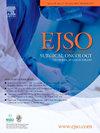吲哚菁绿可突出淋巴引流路径,提高中下段直肠癌根治术的效果:一项非随机对照前瞻性研究。
IF 3.5
2区 医学
Q2 ONCOLOGY
引用次数: 0
摘要
背景:使用吲哚菁绿(ICG)荧光引导淋巴结切除术(FLND)已成为一种很有前途的技术,可以提高直肠癌手术中淋巴结切除术的准确性。有效的淋巴结切除术对改善晚期直肠癌患者的预后至关重要,但在技术上仍具有挑战性和争议性。方法:本前瞻性非随机对照研究纳入129例腹腔镜手术患者和64例FLND辅助患者。患者术前接受粘膜下ICG注射以促进FLND。淋巴结根据其解剖位置分为251站、252站或253站。通过比较FLND组和对照组之间淋巴结切除和转移的数量来评估FLND的有效性。结果:与对照组相比,FLND组收获的253个淋巴结中位数显著增加(2.0比1.0,P = 0.007)。FLND组术后住院时间较短(6天vs. 8天)。结论:FLND辅助根治性手术显著提高了中低位直肠癌淋巴结切除术的准确性和成活率,提高了手术效果和患者预后。未来荧光成像和相关技术的发展有望进一步提高该技术的临床有效性。本文章由计算机程序翻译,如有差异,请以英文原文为准。
Indocyanine green highlights the lymphatic drainage pathways, enhancing the effectiveness of radical surgery for mid-low rectal cancer: A non-randomized controlled prospective study
Background
Fluorescence-guided lymphadenectomy (FLND) using indocyanine green (ICG) has emerged as a promising technique to enhance the accuracy of lymphadenectomy in rectal cancer surgery. Effective lymphadenectomy is crucial for improving prognosis in patients with advanced rectal cancer, but it remains technically challenging and controversial.
Methods
This prospective nonrandomized controlled study was conducted involving 129 patients underwent laparoscopic surgery, and 64 patients assisted by FLND. Patients received submucosal ICG injections before surgery to facilitate FLND. Lymph nodes were categorized as station 251, station 252, or station 253 based on their anatomical locations. The effectiveness of FLND was evaluated by comparing the number of harvested and metastatic lymph nodes between the FLND and control groups.
Results
The FLND group demonstrated a significantly higher median number of harvested station 253 lymph nodes compared to the control group (2.0 vs. 1.0, P = 0.007). The FLND cohort had a shorter postoperative hospital stay (6 days vs. 8 days, P < 0.001) and similar rates of postoperative complications compared to the control cohort. The study found no significant differences in the median number of harvested station 251 (10.0 vs. 11.0, P = 0.872) and station 252 (6.0 vs. 5.0, P = 0.369) lymph nodes between the groups. Univariate and multivariate analyses indicated that FLND significantly increased the harvested lymph node count.
Conclusion
Radical surgery assisted by FLND significantly improves the accuracy and yield of lymphadenectomy in mid-low rectal cancer, enhancing surgical outcomes and patient prognosis. Future advancements in fluorescence imaging and related technologies hold promise for further improving the clinical effectiveness of this technique.
求助全文
通过发布文献求助,成功后即可免费获取论文全文。
去求助
来源期刊

Ejso
医学-外科
CiteScore
6.40
自引率
2.60%
发文量
1148
审稿时长
41 days
期刊介绍:
JSO - European Journal of Surgical Oncology ("the Journal of Cancer Surgery") is the Official Journal of the European Society of Surgical Oncology and BASO ~ the Association for Cancer Surgery.
The EJSO aims to advance surgical oncology research and practice through the publication of original research articles, review articles, editorials, debates and correspondence.
 求助内容:
求助内容: 应助结果提醒方式:
应助结果提醒方式:


